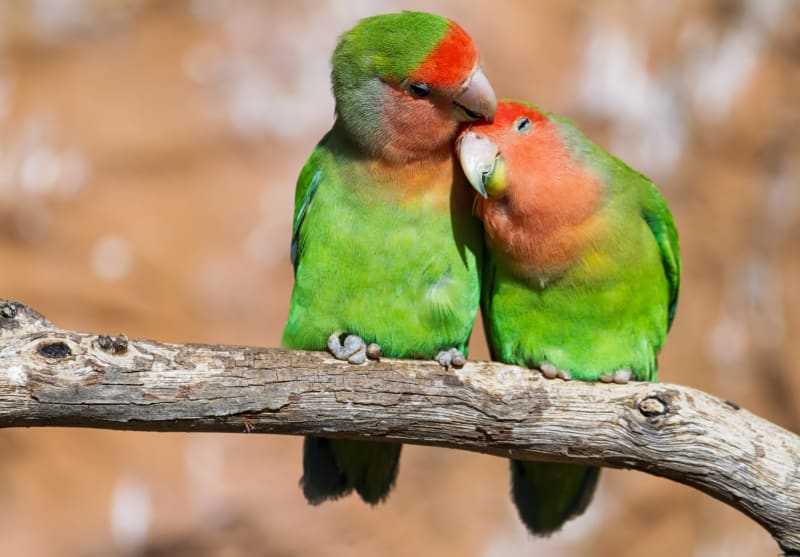
Top 5 Friendly Bird Breeds Perfect for First-Time Pet Owners
Bringing a pet bird into your home can be one of the most rewarding decisions you make. Birds are intelligent, social, and full of personality, often becoming beloved companions for their owners. However, not all bird species are suitable for beginners. Some require specialized care, advanced training, or a lot of time and patience. For first-time bird owners, it’s best to start with breeds that are friendly, easy to handle, and relatively low-maintenance.
🐶 Pet Star
40 min read · 5, Oct 2025

Introduction
Birds are captivating, intelligent, and social creatures that can bring joy, companionship, and beauty into your home. However, choosing the right bird as a first-time pet is crucial. Some species are more adaptable, friendly, and easier to care for, while others require extensive attention, training, and experience.
For first-time bird owners, the ideal pet should be social, easy to handle, and low-maintenance without compromising on interaction and affection. Beyond choosing the right breed, providing mental stimulation, proper diet, and daily interaction is key to fostering a happy and healthy pet bird.
In this article, we’ll explore the top 5 friendly bird breeds perfect for beginners, what makes them great companions, their care needs, enrichment activities, and tips to ensure your feathered friend thrives in your home. Bringing a pet bird into your home can be one of the most rewarding decisions you make. Birds are intelligent, social, and full of personality, often becoming beloved companions for their owners. However, not all bird species are suitable for beginners. Some require specialized care, advanced training, or a lot of time and patience. For first-time bird owners, it’s best to start with breeds that are friendly, easy to handle, and relatively low-maintenance. Here are the top five bird breeds that are perfect for beginners who want a feathered friend that’s affectionate, lively, and easy to care for.
1. Budgerigar (Budgie or Parakeet)
Budgerigars, commonly known as budgies, are one of the most popular pet birds in the world—and for good reason. These tiny parrots are colorful, charming, and incredibly friendly. They are known for their playful behavior, sweet chirps, and strong bond with their owners. Budgies can be trained to do simple tricks, perch on your finger, and even mimic words or phrases with regular practice.
Their small size makes them easy to house, and their diet is simple, consisting mainly of seeds, fruits, and vegetables. Budgies are also quite social and love interaction, but they can do well both individually (with lots of human attention) or in pairs. What makes them especially great for beginners is their adaptability—they adjust quickly to new environments and routines.
Budgies are low-maintenance compared to larger parrots, but they still need daily socialization and stimulation through toys and interaction. They live around 7 to 10 years on average, though with good care, some can reach up to 15 years.
2. Cockatiel
Cockatiels are another top choice for first-time bird owners, thanks to their affectionate and gentle nature. These Australian natives are smaller cousins of the cockatoo and have a signature crest that reflects their mood—standing tall when curious or excited and flattening when relaxed.
Cockatiels are extremely social and enjoy spending time with humans. They’re known for their whistling skills rather than talking, and males, in particular, can learn to mimic tunes or household sounds. They love sitting on shoulders, being petted, and following their owners around.
One of the best qualities of cockatiels is their calm temperament. They are not overly demanding and usually get along well with other birds. Their diet is easy to maintain, consisting of pellets, seeds, and fresh vegetables. Cockatiels are also great for those who want a cuddly bird without the overwhelming noise or care requirements of larger parrots. With proper care, cockatiels can live 15 to 20 years, offering long-term companionship.
3. Lovebird
Despite their name, lovebirds don’t have to be kept in pairs—though they do enjoy companionship. They are small parrots known for their bright plumage and strong personalities. While slightly more energetic than budgies or cockatiels, lovebirds are affectionate and bond closely with their owners, making them great for people who can give them daily attention.
Lovebirds are playful, intelligent, and curious. They love climbing, exploring, and playing with toys. Training them requires consistency, but they can become very tame with regular handling from a young age. Their vocalization is usually cheerful chirping, and they’re less noisy than many other parrot species.
Their diet mainly includes seeds, fruits, and leafy greens, and their cage should be spacious enough for flying and playing. Lovebirds live around 10 to 15 years and make wonderful companions for those who enjoy interactive pets full of energy and affection.
4. Parrotlet
If you’re looking for a small bird with the personality of a big parrot, the parrotlet might be your perfect match. These tiny birds are fearless, curious, and full of charm. Despite their size, they have bold personalities and love interacting with their owners. Parrotlets are highly intelligent and can be trained to perform tricks or learn words, though they tend to have softer voices compared to larger parrots.
What makes parrotlets suitable for beginners is their manageable care routine. They require daily socialization but are not overly demanding. However, they should be handled gently and consistently; otherwise, they may become a bit feisty or independent.
Parrotlets thrive on a diet of pellets, seeds, fruits, and vegetables. They need toys and space for exercise, as they are active and playful. These birds are loyal and affectionate once bonded and can live between 15 to 20 years, providing years of companionship in a compact, colorful package.
5. Canary
For those who prefer a bird that’s beautiful to watch and listen to but not necessarily handle, the canary is an ideal choice. Canaries are known for their melodious singing, especially males, and come in various stunning colors such as yellow, red, and white. They are generally independent birds that don’t require much physical interaction but still enjoy a calm, pleasant environment.
Canaries are easy to care for and do well in spacious cages where they can fly short distances. They love fresh air and sunlight but should be kept away from drafts. Their diet mainly includes canary seed mix, vegetables, and occasional fruit treats.
One of the biggest appeals of canaries is their cheerful, soothing song that fills the home with positive energy. They are perfect for beginners who want a pet that brings life and happiness without requiring hands-on interaction. Canaries typically live for about 8 to 10 years, sometimes longer with excellent care.
Final Thoughts
Choosing the right bird depends on your lifestyle, time, and the kind of companionship you want. Budgies and cockatiels are great for those who want a playful, interactive pet. Lovebirds and parrotlets are ideal if you’re ready for a slightly more engaging, energetic bond. Meanwhile, canaries suit people who prefer a low-touch, peaceful presence.
No matter which breed you choose, every bird deserves love, patience, and attention. With proper care, they’ll reward you with affection, laughter, and a unique friendship that can brighten your days for years. For first-time bird owners, these friendly species are the perfect way to experience the joy of feathered companionship while learning the beautiful responsibility of caring for a life.
1. Budgerigar (Budgie / Parakeet)
Overview:
Budgies are small, vibrant birds known for their playful personalities and intelligence. They are one of the most popular choices for first-time bird owners due to their manageable size, easy care, and social nature.
Why They’re Friendly:
- Naturally curious and playful
- Enjoy interacting with humans
- Can learn to mimic sounds or words
- Gentle temperament suitable for families or single owners
Care Tips:
- Cage size: Minimum 18x18 inches for a single budgie
- Diet: Seeds, pellets, fresh fruits, and vegetables
- Social needs: Daily interaction and talking or whistling with them
DIY Enrichment Ideas:
- Paper or cardboard chew toys
- Hanging swings or ladders in the cage
- Treats hidden inside a small DIY foraging toy
- Mirror or bell for occasional stimulation
2. Cockatiel
Overview:
Cockatiels are affectionate medium-sized birds with elegant crests and charming personalities. They are known for their whistling skills and social bonds with humans.
Why They’re Friendly:
- Love human attention and often enjoy being petted
- Gentle and rarely aggressive
- Can learn tricks and whistles
- Good for homes with limited space
Care Tips:
- Cage size: At least 24x18 inches
- Diet: High-quality pellets, seeds, leafy greens, and fruits
- Grooming: Regular nail trimming and occasional wing care
DIY Enrichment Ideas:
- Create foraging boxes using cardboard and shredded paper
- DIY swing using sturdy ropes and wood
- Small DIY ladders and climbing ropes
- Offer puzzle toys for treat rewards
3. Lovebirds
Overview:
Lovebirds are small, social, and colorful parrots. True to their name, they form strong bonds with their human caregivers or paired companions.
Why They’re Friendly:
- Affectionate and playful
- Curious and interactive with their environment
- Can bond closely with their owner if handled daily
- Ideal for someone ready to invest time in interaction
Care Tips:
- Cage size: Minimum 18x18x18 inches for a single bird
- Diet: Pellets, seeds, fruits, and vegetables
- Social needs: Require at least a few hours of daily attention
- Prevent boredom: Rotate toys and add interactive play
DIY Enrichment Ideas:
- Paper foraging tubes filled with treats
- Hanging swings and ropes for climbing
- Shreddable cardboard toys
- DIY puzzle feeders with small hidden treats
4. Canary
Overview:
Canaries are known for their beautiful songs and calm nature. They are ideal for owners who enjoy observing peaceful birds rather than constant handling.
Why They’re Friendly:
- Low-maintenance compared to parrots
- Excellent for beginners due to gentle temperament
- Pleasant singing adds ambiance to the home
- Require minimal daily interaction but thrive with attention
Care Tips:
- Cage size: Minimum 18x18x18 inches
- Diet: Seeds, pellets, occasional fresh vegetables
- Provide daily fresh water and regular cleaning
DIY Enrichment Ideas:
- Hanging swings or perches for exercise
- Natural branches for chewing and climbing
- DIY shredded paper or grass mats for foraging
- Rotate toys weekly for variety
5. Green-Cheeked Conure
Overview:
Green-cheeked conures are small parrots that pack playful energy and affection in a compact size. They are known for their intelligence, curiosity, and loving personality.
Why They’re Friendly:
- Social and playful, enjoy human interaction
- Less noisy than larger parrots, making them apartment-friendly
- Can learn tricks and interactive games
- Bond strongly with owners
Care Tips:
- Cage size: At least 24x24 inches
- Diet: Pellets, seeds, fruits, vegetables
- Daily interaction is essential for social well-being
- Provide chewable toys to prevent boredom
DIY Enrichment Ideas:
- Rope swings and ladders
- DIY treat puzzles using paper or cardboard
- Small safe chewable wood or branches
- Foraging toys to stimulate their curiosity
Daily Interaction & Enrichment Routine
Morning
- Greet your bird and spend 10–15 minutes talking or whistling
- Offer fresh water and food
- Place DIY toys or foraging activity in the cage
Midday
- Short out-of-cage time for flying or play (if safe)
- Rotate toys or offer new treat puzzles
- Observe their behavior and note curiosity or boredom
Evening
- Calm interaction: gentle petting, hand-feeding fruits
- Remove old food, refresh water, and clean perches
- Quiet music or soft sounds for relaxation
Weekly Practices
- Deep clean the cage and accessories
- Introduce a new toy or enrichment activity
- Train a small trick or recall exercise
- Socialize with family or other pets if appropriate
Common Mistakes & How to Avoid Them
❌ Choosing based on color, not temperament
✅ Research breed behavior and needs before adopting
❌ Overcrowding cages
✅ Give birds space to fly, climb, and explore
❌ Ignoring mental stimulation
✅ Birds need daily toys, puzzles, and interaction
❌ Neglecting diet variety
✅ Mix pellets, seeds, fruits, and vegetables
❌ Not monitoring health
✅ Watch for feather plucking, lethargy, or changes in droppings
Bird Care Myths: Busted!
“Small birds don’t need interaction.”
→ False! Even tiny birds thrive on daily attention and mental stimulation.
“Birds only need seeds.”
→ Seeds alone are nutritionally insufficient. Fresh veggies, pellets, and occasional fruits are essential.
“All birds can talk or mimic sounds.”
→ Only certain species, like budgies and cockatiels, are natural mimics.
“Birds are low-maintenance pets.”
→ Birds require daily cleaning, socialization, and enrichment to stay healthy.
“Once they bond, training isn’t needed.”
→ Continuous training helps mental stimulation and builds trust.
Conclusion
Choosing a friendly bird breed for your first pet can set the foundation for a joyful and lifelong companionship. Budgerigars, cockatiels, lovebirds, canaries, and green-cheeked conures are excellent options for beginners—they are social, affectionate, and adaptable, making them easier to care for while still providing endless interaction and entertainment.
DIY enrichment activities and regular mental stimulation are key to a happy, healthy pet bird. From homemade toys and foraging puzzles to swings and climbing ladders, these activities reduce boredom, strengthen the bond with your bird, and enhance their physical and emotional well-being.
Start with patience, consistency, and love. Observe your bird, try different enrichment activities, and watch your feathered friend thrive—chirping, singing, playing, and interacting in ways that make your home brighter every day.
Bring a bird into your life. Enrich their world. Enjoy the companionship. Your first-time bird ownership journey will be rewarding, joyful, and full of chirps, wings, and wagging tails of happiness.
Q&A Section
Q1:- Why are budgerigars (budgies) considered the best birds for beginners?
Ans :- Budgies are small, playful, and easy to care for. They quickly learn to mimic sounds and bond closely with owners, making them ideal for first-time bird keepers.
Q2:- What makes cockatiels friendly and affectionate pets?
Ans :- Cockatiels are gentle, social birds known for their whistling and cuddly nature. They enjoy human interaction and are easy to train, making them wonderful companions for beginners.
Q3:- How do lovebirds show affection towards their owners?
Ans :- Despite their name, lovebirds aren’t just affectionate to partners—they form strong bonds with owners too. They love perching on shoulders, playing, and expressing affection through gentle chirps.
Q4:- Why are canaries a good choice for people who prefer less handling?
Ans :- Canaries are low-maintenance and love to sing beautifully. They don’t require much physical interaction but bring joy with their songs and vibrant colors, perfect for peaceful homes.
Q5:- What makes finches suitable for beginners?
Ans :- Finches are hardy, social, and thrive in pairs or groups. They don’t need hand-taming, making them a great option for those who want a cheerful pet without much handling.
Q6:- How should beginners prepare the right environment for these birds?
Ans :- Provide a spacious cage, clean water, balanced food, toys, and perches. Regular cleaning, fresh fruits, and daily interaction help maintain a healthy, happy bird.
Q7:- What common mistakes should first-time bird owners avoid?
Ans :- Avoid small cages, loud noises, poor diets, and neglecting social time. Birds need stimulation, fresh air, and gentle care to remain active and friendly.
Q8:- Can these friendly bird breeds learn to talk or mimic sounds?
Ans :- Yes! Budgies and cockatiels especially can learn words and tunes with regular talking sessions. Lovebirds may mimic sounds, though canaries and finches mostly sing melodious songs.
Q9:- How long do these beginner-friendly bird species usually live?
Ans :- With proper care, budgies and lovebirds live 8–12 years, cockatiels about 15–20 years, while canaries and finches average 5–10 years, depending on diet and care.
Q10:- What are the emotional benefits of keeping these birds as pets?
Ans :- Birds bring joy, reduce stress, and fill homes with music and color. Their playful behavior and loving nature offer emotional comfort and companionship to their owners.
Similar Articles
Find more relatable content in similar Articles

Virtual Vet Visits: Are Online Consultations Reliable?..
As pet healthcare embraces dig.. Read More

Pets and Mental Health: The Science Behind Emotional H..
Discover the profound impact o.. Read More

Composting Pet Waste: A Greener Way to Clean Up...
As pet ownership continues to .. Read More

Social Media for Pets: Turning Your Pet into a Digital..
From playful puppies to charis.. Read More
Explore Other Categories
© 2024 Copyrights by rPets. All Rights Reserved.